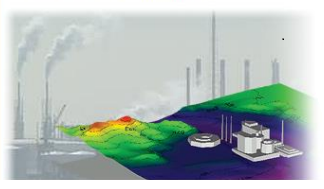Air toxics: Modeling
Overview
Modeling is a process that uses computers and math to estimate air pollution and associated human health exposures. Dispersion modeling is a type of modeling that estimates how air pollution will likely spread out over an area based on a variety of different factors. These factors can include reported or measured emission rates, local meteorological data and details about the specific facility, such as stack heights or fenceline boundaries. The AERMOD dispersion modeling system developed in part by the U.S. Environmental Protection Agency is used to show how pollution spreads through the air.
Figure 1: AERMOD dispersion model output showing emission sources and pollution locations.
Exposure models such as the human exposure model or the hazardous air pollutant exposure model can use these ambient air concentrations to predict potential human exposures. These models can give us information to assess potential risk for cancer and non-cancer health effects from air toxics.
By applying the hazardous air pollutant exposure model to nationally available emission and meteorological datasets, the EPA has developed a national screening tool called AirToxScreen to characterize health risks from over 100 different air toxics across the country.
The department uses AirToxScreen results to prioritize places for more detailed follow-up investigations. The follow-up work may include site- or community-specific studies. For example:
- In 2018 AirToxScreen showed elevated health risks from ethylene oxide emissions at a commercial sterilizer in Lakewood, Colorado, and the department initiated more detailed investigations.
- The AirToxScreen showed elevated health risks from oil and gas drilling and fracking emissions concentrated in Weld County from 2017 to 2020. The department initiated sampling to validate and prepare corrections for the model results.
EPA applies the human exposure model during the rulemaking processes for the National Emission Standards for Hazardous Air Pollutants (NESHAP). The human exposure model estimates potential health risks for cancer and non-cancer health effects on communities in close proximity to specific facilities subject to the regulations. These estimated risks inform decisions about what types of air pollution control strategies may be required.
